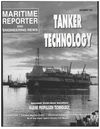
Page 131: of Maritime Reporter Magazine (September 1997)
Read this page in Pdf, Flash or Html5 edition of September 1997 Maritime Reporter Magazine
CYLINDER LINERS FOR ALL
APPLICATIONS INCLUDING
MARINE DIESELS
P.O. Box :127 Carsi TR-01322 ADANA/TURKEY
Tel: +90 322 4410012 Fax : +90 322 4410086 • Flexibility of supply • Fully machine or semimachine cylinder liners for your tailor made requirements • Highest quality of material and machining. • And more applications of cylinder liners for Industrial and Heavy Duty
Engines, Locomotives, Compressors, etc. eiiean "Manufacturers of Cylinder Liner"
Responsive
Service
QUALITY PROPELLERS
STONE MARINE CANADA
BRONZE PROPELLER MANUFACTURER: 60"-250"
Iberville, Quebec
Tel: (514)347-3789 • Fax: (514)358-2795
Quality products and service you can depend on • Marine Evacuation
Circle 415 on Reader Service Card Circle 360 on Reader Service Card
Circle 259 on Reader Service Card 133
U. S. Agent ®1®METRIC MARINE SERVICES
Tel: (800)644-2601 • Fax: (904)241-2733 • Life rafts; throw overboard davit launch &
IBA type
Systems • Life jackets
LIFE-SAVING EQUIPMENT ' Survival Suits • Fire Suits
Over 300 service facilities worldwide
Viking Life-Saving Equipment (America), Inc. 1625 N. Miami Ave, Miami • Florida 33136
Ph: (305) 374-5115 Fax: (305)374-1535 (Continued from page 116)
Inmarsat communications system, both of which have proved their reliability over many years of use by mariners and others. The use of geostationary satellites greatly increases the speed at which a distress alert can be delivered, as no time is lost waiting for a satellite to appear over the horizon.
The system features both float free buoy type
EPIRBs (emergency position indicating radio beacons) for use onboard larger vessels as well as hand portable versions for yachts, lifeboats and similar applications.
Both types of terminal include a built in GPS receiver so that the position of the unit is con- stantly updated to an accuracy of better than 61 ft. (200 m). This compares with an accuracy of about five kilometers for the best of the current emergency alerting systems. The terminals also include an Inmarsat satellite communica- tions transmitter which automatically trans- nits the coded distress alert to all accessible "nmarsat satellites.
Inmarsat transmitters use the L band range if frequencies, specifically allocated for search ind rescue (SAR) maritime communications >ecause they are virtually unaffected by idverse meteorological conditions and interfer- nce from other L band spectrum users.
Improved power budget, made possible brough the three new Inmarsat E satellites lunched last year, leads to a much better ransfer of distress messages through the satel- te. A distress signal can be triggered manu- lly or automatically when a float free terminal i submerged. As a minimum the message will mtain the identity of the terminal and its posi- on at the time of the alert. This information will be transmitted via an Inmarsat satellite to an LES where it will trigger an alarm while being automatically relayed via a fixed landline connection, to a Rescue Coordination Center (RCC). Many vessels will carry an on bridge display showing the status and position reading from the EPIRB. In an emergency, crew mem- bers will have the option of triggering an alert transmission and including, via a short code keyboard, additional information on the nature of the emergency. Similar information can be input by the user of a portable terminal. Once triggered, terminals will continue transmitting for 48 hours unless de-activated manually.
Some models will also feature a search and res- cue radar transponder (SART) beacon to enable rescuers to home-in using radar once they reach the area of the transmitted position.
Land earth stations (LESs) operating with the (Continued on page 133) Krieger Inmarsat E EPIRB
September, 1997
Flash is a trademark of DC Comics.
Used with permission.
Copyright ©1994 DC Comics (800)572-1717
HELP SPEED THE SEARCH
FOR CURES FOR MUSCULAR
DYSTROPHY!

 130
130

 132
132
